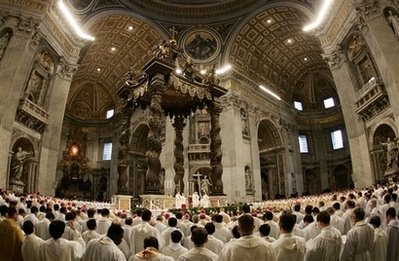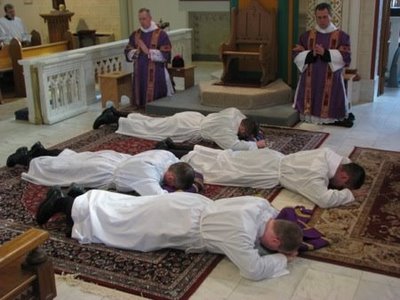Celibacy wars: In very brief
 Journalists who have been around for a few decades may remember one of the "in" jokes that circulated after the birth of USA Today, the joke that claimed that there was going to be a new Pulitzer Prize awarded for the best investigative paragraph. That joke isn't very funny for the journalists who are being asked to handle giant, complex topics in smaller and smaller amounts of space on faster and faster deadlines. That joke jumped in to my mind the other day after reading this micro-feature published in Time as a kind of "news you can use" backgrounder in the wake of the Father Alberto Cutié scandal down on South Beach.
Journalists who have been around for a few decades may remember one of the "in" jokes that circulated after the birth of USA Today, the joke that claimed that there was going to be a new Pulitzer Prize awarded for the best investigative paragraph. That joke isn't very funny for the journalists who are being asked to handle giant, complex topics in smaller and smaller amounts of space on faster and faster deadlines. That joke jumped in to my mind the other day after reading this micro-feature published in Time as a kind of "news you can use" backgrounder in the wake of the Father Alberto Cutié scandal down on South Beach.
There but for the grace of God go we. Right religion-beat pros? Your assignment is to give an overview of the history of clerical celibacy in the Roman church -- 300 words or less. Ready? Here is -- yes, I fool you not -- most of that news-magazine report:
It wasn't until the 12th century that formal rules were established forbidding clergymen to have sex. According to the Gospel of Matthew, Peter himself had a mother-in-law (which would usually imply a wife as well). The ban had theological roots -- abstaining from pleasures of the flesh to demonstrate one's commitment to the church -- but there was a practical reason too: celibacy meant no offspring vying to inherit church property. That's not to say the rules were always followed, however. Many priests' spirits proved weak and their flesh willing -- notably the sybaritic Pope Alexander VI, who installed his teenage son as an Archbishop in 1493. Fernando Lugo, the current President of Paraguay and a former bishop, is accused of fathering three children as a man of the cloth. And while abstinence does not inevitably lead to child molestation, critics are quick to draw a link between priestly celibacy and recent pedophilia scandals.
At the Second Vatican Council in the early 1960s, hopes that the church would abandon celibacy were dashed by the election of the conservative Paul VI. A severe shortage of priests may prompt the church to reconsider. Since Vatican II, seminary enrollment has dropped 75%. Cutié, suspended from clerical duties, is grappling over whether to wed his girlfriend of two years. If he takes the secular path, he won't be alone: an estimated 25,000 former priests are married and living in the U.S. today.
It's a compliment to the reporters and editors still at Time that the major problems in this "report" have to do with what is missing, as opposed to outright errors that made it into the text.
Catholic readers! Click comment and tell us what you would add.
But let's play fair. If you add, oh, 10 words of new content you also have to tell us what you would take out, too. You might want to try using those nifty LeBlanc-esque delete marks with the strike-out line through them.
Meanwhile, our friend Eric Gorski at the Associated Press is out with a wire-service feature on the same topic, which ran in USA Today under the headline, "Celibacy questions haunt scandalized priest."
 People often use "wire-service writing" as a kind of smear phrase, suggesting that it's impossible to offer any significant information in the short formats that dominate this form of mainstream news. But look at that Time copy again and then compare it with a short chunk of the AP report:
People often use "wire-service writing" as a kind of smear phrase, suggesting that it's impossible to offer any significant information in the short formats that dominate this form of mainstream news. But look at that Time copy again and then compare it with a short chunk of the AP report:
With few exceptions, becoming a Catholic priest in the Western church requires a vow of celibacy, meaning no sexual relations or marriage. Although celibacy is a tradition dating to the church's earliest days, it was not made mandatory until the 11th century. The celibate priesthood has been modified over the years. The Catholic church in the West has made room for married clergy from other denominations to become Catholic priests and stay married. Celibacy is optional for Eastern Rite priests.
However, here is the part of the story that caught my attention. This is the kind of complex issue that is so hard to crunch into a small number of words without making serious errors.
A survey in 2003 by the Center for Applied Research in the Apostolate at Georgetown University found that 74% of non-Latino Catholics believed married men should be ordained as priests. Just 45% of U.S. Latino Catholics held that position. Two years ago, a Pew survey found a similar result -- 44% of nonwhite Hispanic Catholics thought married men should be allowed to become priests.
Those numbers do not tell the whole story about Hispanic Catholics and celibacy, however. The 2003 survey also found that male Latino Catholics were less likely than male non-Latino Catholics to have considered becoming a priest or brother -- 13% compared to 24%.
Basically, Hispanic Catholics are believers in the current rules for the priesthood. The men just are not rushing to sign up.
The story goes on to deal with a host of other subjects related to this cultural divide, including the lower-t tradition in Latin America that Catholic priests often have live-in girlfriends, while the members of their flocks look the other way.
How does this mix with more the conservative beliefs held by most of the faithful? How does this affect the tensions in Miami, where the two cultures mix and clash?
Check it out. Then click comment and try to tweak -- twit? -- that Time story.